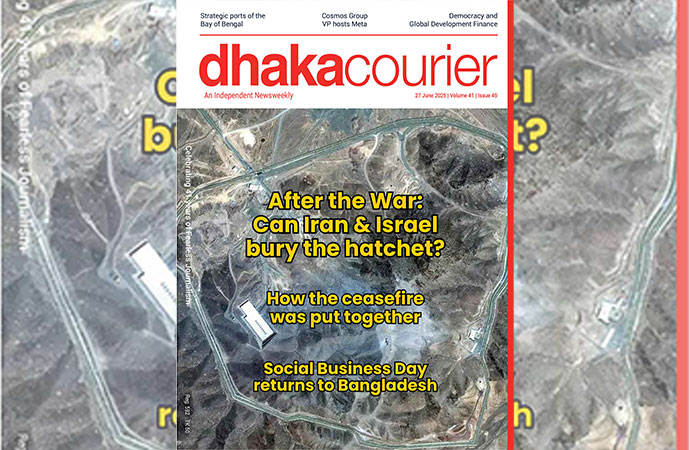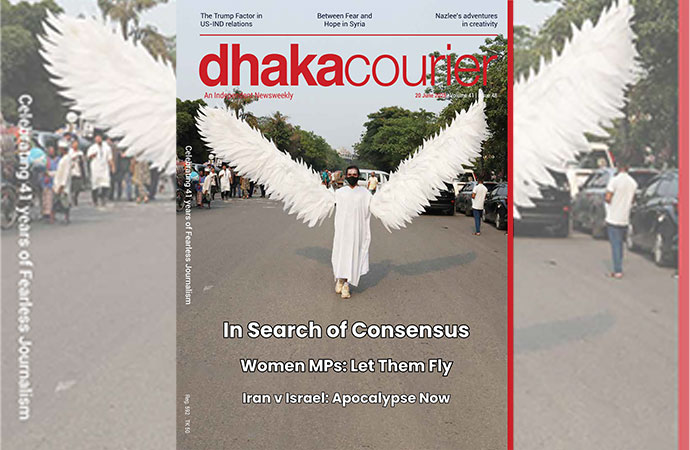Reportage

In this Tuesday, March 10, 2020 file photo, people walk by a giant TV screen at a quiet shopping mall in Beijing broadcasting news of Chinese President Xi Jinping talking to medical workers at the Huoshenshan Hospital in Wuhan in central China’s Hubei Province, as he visited the center of the global virus outbreak. (AP/UNB Photo)
Deep in the lush mountain valleys of southern China lies the entrance to a mine shaft that once harboured bats with the closest known relative of the COVID-19 virus. The area is of intense scientific interest because it may hold clues to the origins of the coronavirus that has killed more than 1.7 million people worldwide by the end of 2020. Yet for scientists and journalists, it has become a black hole of no information because of political sensitivity and secrecy.
A bat research team visiting recently managed to take samples but had them confiscated, two people familiar with the matter said. Specialists in coronaviruses have been ordered not to speak to the press. And a team of Associated Press journalists was tailed by plainclothes police in multiple cars who blocked access to roads and sites in late November.
More than a year since the first known person was infected with the coronavirus, the international politicking over its origins, and the tendency to tie it to attribution of blame, has crippled efforts even in the interest of research into its origins. Beijing is actively clamping down on some while promoting theories that it could have come from outside China.
The government is handing out hundreds of thousands of dollars in grants to scientists researching the virus' origins in southern China and affiliated with the military, the AP has found. But it is monitoring their findings and mandating that the publication of any data or research must be approved by a new task force managed by China's cabinet, under direct orders from President Xi Jinping, according to internal documents obtained by the AP.
A rare leak from within the government, the dozens of pages of unpublished documents confirm what many have long suspected: The clampdown comes from the top. As a result, very little has been made public. Authorities are severely limiting information and impeding cooperation with international scientists.
"What did they find?" asked Gregory Gray, a Duke University epidemiologist who oversees a lab in China studying the transmission of infectious diseases from animals to people. "Maybe their data were not conclusive, or maybe they suppressed the data for some political reason. I don't know ... I wish I did."
Some Chinese scientists say little has been shared simply because nothing of significance has been discovered. "We've been looking, but we haven't found it," said Zhang Yongzhen, a renowned Chinese virologist.
China's leaders are far from alone, or even the most culpable, in politicizing research into the origins of the virus. For that, one can hardly look beyond Washington, where the combative and divisive rhetoric of Donal Trump served to even politicise masks by the end, as the country became the world's worst-affected in the pandemic. In April, President Trump shelved a U.S.-funded project to identify dangerous animal diseases in China and Southeast Asia, effectively severing ties between Chinese and American scientists and complicating the search for virus origins. Trump also has accused China of setting off the pandemic through an accident at a Wuhan lab - a theory that some experts say cannot be ruled out but as yet has no evidence behind it.
Ironically, it is Trump's handling of the US outbreak - broadly marked by a deference to states authority when a strong federal response was the need of the hour- most likely cost him reelection at the end of the year.
Research into COVID-19's origins is critical to the prevention of future pandemics. Although a World Health Organization international team plans to visit China in early January to investigate what started the pandemic, its members and agenda had to be approved by China.
Some public health experts warn that China's refusal to grant further access to international scientists has jeopardized the global collaboration that pinpointed the source of the SARS outbreak nearly two decades ago. Jonna Mazet, a founding executive director of the UC Davis One Health Institute, said the lack of collaboration between Chinese and U.S. scientists was "a disappointment" and the inability of American scientists to work in China "devastating."
"There's so much speculation around the origins of this virus," Mazet said. "We need to step back...and let scientists get the real answer without the finger-pointing."
The hidden hunt for the origins of COVID-19 shows how the Chinese government has tried to steer the narrative. The search started in the Huanan Seafood market in Wuhan, a sprawling, low-slung complex where many of the first human coronavirus cases were detected. Scientists initially suspected the virus came from wild animals sold in the market, such as civet cats implicated in the spread of SARS.
In mid-December last year, Huanan vendor Jiang Dafa started noticing people were falling ill. Among the first was a part-time worker in his 60s who helped clean carcasses at a stall; soon, a friend he played chess with also fell ill. A third, a seafood monger in his 40s, was infected and later died.
Patients began trickling into nearby hospitals, triggering alarms by late December that alerted the China CDC. CDC chief Gao Fu immediately sent a team to investigate.
At first, research appeared to be moving swiftly.
Overnight on Jan. 1, the market suddenly was ordered shut, barring vendors from fetching their belongings, Jiang said. China CDC researchers collected 585 environmental samples from door handles, sewage and the floor of the market, and authorities sprayed the complex down with sanitizer. Later, they would cart out everything inside and incinerate it.
Internal China CDC data obtained by the AP shows that by Jan. 10 and 11, researchers were sequencing dozens of environmental samples from Wuhan. Gary Kobinger, a Canadian microbiologist advising WHO, emailed his colleagues to share his concerns that the virus originated at the market.
"This corona(virus) is very close to SARS," he wrote on Jan. 13. "If we put aside an accident ... then I would look at the bats in these markets (sold and 'wild')."
By late January, Chinese state media announced that 33 of the environmental samples had tested positive. In a report to WHO, officials said 11 specimens were more than 99% similar to the new coronavirus. They also told the U.N. health agency that rats and mice were common in the market, and that most of the positive samples were clustered in an area where vendors traded in wildlife.
In the meantime, Jiang avoided telling people he worked at Huanan because of the stigma. He criticized the political tussle between China and the U.S.
"It's pointless to blame anyone for this disease," Jiang said.
A China CDC lab notice on Feb. 24 put in new approval processes for publication under "important instructions" from Chinese President Xi Jinping. Other notices ordered CDC staff not to share any data, specimens or other information related to the coronavirus with outside institutions or individuals.
Then on March 2, Xi emphasized "coordination" on coronavirus research, state media reported.
The next day, China's cabinet, the State Council, centralized all COVID-19 publication under a special task force. The notice, obtained by the AP and marked "not to be made public," was far more sweeping in scope than the earlier CDC notices, applying to all universities, companies and medical and research institutions.
On May 25, CDC chief Gao finally broke the silence around the market in an interview with China's Phoenix TV. He said that, unlike the environmental samples, no animal samples from the market had tested positive.
The announcement surprised scientists who didn't even know Chinese officials had taken samples from animals. It also ruled out the market as the likely source of the virus, along with further research that showed many of the first cases had no ties to it.
With the market proving a dead end, scientists turned more attention to hunting for the virus at its likely source: bats.
Batcaves in Yunnan
Nearly a thousand miles away from the wet market in Wuhan, bats inhabit the maze of underground limestone caves in Yunnan province. With its rich, loamy soil, fog banks and dense plant growth, this area in southern China bordering Laos, Vietnam and Myanmar is one of the most biologically diverse on earth.
At one Yunnan cave visited by the AP, with thick roots hanging over the entrance, bats fluttered out at dusk and flew over the roofs of a nearby small village. White droppings splattered the ground near an altar in the rear of the cave, and Buddhist prayer strings of red and yellow twine hung from the stalactites. Villagers said the cave had been used as a sacred place presided over by a Buddhist monk from Thailand.
Contact like this between bats and people praying, hunting or mining in caves alarms scientists. The coronavirus' genetic code is strikingly similar to that of bat coronaviruses, and most scientists suspect COVID-19 jumped into humans either directly from a bat or via an intermediary animal.
Since bats harbouring coronaviruses are found in China and throughout Southeast Asia, the wild animal host of COVID-19 could be anywhere in the region, said Linfa Wang at Duke-NUS Medical School in Singapore.
"There is a bat somewhere with a 99.9% similar virus to the coronavirus," Wang said. "Bats don't respect these borders.
COVID-19 research is proceeding in countries such as Thailand, where Dr. Supaporn Wacharapluesadee, a coronavirus expert, is leading teams of scientists deep into the countryside to collect samples from bats. During one expedition in August, Supaporn told the AP the virus could be found "anywhere" there were bats.
Chinese scientists quickly started testing potential animal hosts. Records show that Xia Xueshan, an infectious diseases expert, received a 1.4 million RMB ($214,000) grant to screen animals in Yunnan for COVID-19. State media reported in February that his team collected hundreds of samples from bats, snakes, bamboo rats and other animals, and ran a picture of masked scientists in white lab coats huddled around a large, caged porcupine.
Then the government restrictions kicked in. Data on the samples still has not been made public, and Xia did not respond to requests for an interview. Although Xia has co-authored more than a dozen papers this year, an AP review shows, only two were on COVID-19, and neither focused on its origins.
Today, the cave where researchers in 2017 identified the species of bats responsible for SARS is off limits to journalists. At an entrance to a second location, a massive cave teeming with tourists taking selfies, authorities shut the gate on the AP.
Particularly sensitive is the mine shaft where the closest relative of the COVID-19 virus - called "RaTG13" - was found.
RaTG13 was discovered after an outbreak in 2012, when six men cleaning the bat-filled shaft fell ill with mysterious bouts of pneumonia, killing three. The Wuhan Institute of Virology and the China CDC both studied bat coronaviruses from this shaft. And although most scientists believe the COVID-19 virus had its origins in nature, some say it or a close relative could have been transported to Wuhan and leaked by mistake.
Wuhan Institute of Virology bat expert Shi Zhengli has repeatedly denied this theory, but Chinese authorities haven't yet allowed foreign scientists in to investigate.
Some state-backed scientists say research is proceeding as usual. Famed virologist Zhang, who received a 1.5 million RMB ($230,000) grant to search for the virus' origins, said partnering scientists are sending him samples from all over, including from bats in Guizhou in southern China and rats in Henan hundreds of miles north.
"Bats, mice, are there any new coronaviruses in them? Do they have this particular coronavirus?" Zhang said. "We've been doing this work for over a decade. It's not like we just started today."
The WHO has said that it is "highly speculative" to suggest COVID-19 did not start in China. The Chinese state press also has widely covered initial studies from Europe suggesting COVID-19 was found in wastewater samples in Italy and Spain last year. But scientists have largely dismissed these studies, and the researchers themselves acknowledged they did not find enough virus fragments to determine conclusively if it was the coronavirus.
WHO has said more than 500 species of other animals, including cats, ferrets and hamsters, are being studied as possible intermediary hosts for COVID-19.
In the U.S., CDC officials long ago tested roughly 11,000 early samples collected under the flu surveillance program since Jan. 1. And in Italy, researchers recently found a boy who had fallen ill in November 2019 and later tested positive for the coronavirus.
The little information that has dribbled out suggests the virus was circulating well outside Wuhan in 2019. A WHO report written in July but published in November said Chinese authorities had identified 124 cases in December 2019, including five cases outside Wuhan.
Coronavirus expert Peter Daszak, a member of the WHO team, said identifying the pandemic's source should not be used to assign guilt.
"We're all part of this together," he said. "And until we realize that, we're never going to get rid of this problem."
And miscellaneous events...
Nothing could compare with the sheer impact of the Covid-19 pandemic, and the work of newsrooms throughout 2020 reflected that. Indeed, it will continue well into 2021. Here though we look back at some of the major events that left their mark on the outgoing year in Bangladesh at least, including the state of the outbreak in the country.
The pandemic arrives
Bangladesh reported its first coronavirus cases on March 8 and the first death on March 18.
Confirmed coronavirus cases in Bangladesh exceeded 510,080 after the health authorities recorded 932 new cases on December 28. The death toll crossed 7,500 at the year's fag end, rendering it an unprecedented event in the history of independent Bangladesh, even dwarfing the cumulative damage inflicted by dengue in almost two decades since it became endemic in the country.
The government on March 23 declared general holidays from March 26 to April 4, aiming to protect people from being infected by the fast spreading virus as elsewhere in the world.
Later, the holidays were extended five times until April 25 -- first from April 5 to April 9, then from April 10 to April 14, later from April 15 to April 16, then again from April 17 to April 25 and finally from April 25 to May 5.
Ultimately the government decided to allow businesspeople to keep shops and shopping malls open till 4 pm every day maintaining health guidelines during the general holidays extended until May 16 considering Ramadan and Eid-ul-Fitr.
All government, semi-government, autonomous and private offices resumed on May 31 ending a 66-day general holiday amid spike in coronavirus cases and deaths across the country.
The pandemic's local outbreak and the response resulted in the poverty rate, or proportion of people under the poverty line, being pushed up to 35% from 24%, according to a study by CPD.
Millions also lost their jobs as the economy slowed down considerably, although it avoided a contraction unlike most other economies including giant neighbours India. This allowed Bangladesh to overtake India in terms of per capita income in the year's final quarter according to the IMF.
Padma Multipurpose Bridge
The Padma Multipurpose Bridge, the country's flagship development project, neared completion as its main structure became fully visible with the installation of its last span. The last span, named 2S, was installed on pillars 12 and 13 of the bridge at Mawa point around 12:02 pm on December 10.
This is one of the top priority projects of the government as it has planned to strengthen the country's communication network, aiming to give a boost to economic activities.
The construction work on the 6.15-km bridge started in November, 2014 and the mega structure is expected to be open to traffic in 2022.
Once in operation, the Padma Bridge, Bangladesh's largest infrastructure project till date, will connect 21 southern districts with its capital Dhaka and boost the GDP by 1 percent.
Scamming the republic
Law enforcers raided Mirpur and Uttara branches of Regent Hospital on July 6 on charge of issuing fake Covid-19 certificates and charging the admitted patients exorbitant fees.
The Regent Group head office and both hospitals were sealed off and 16 people, including owner Kazi Shahed, were sued on charge of issuing fake coronavirus test reports.
Rab arrested Shahed, a braggart known for boasting of his ties to the ruling party, from the bordering area of Satkhira on July 15. They also recovered a pistol, some bullets and foreign currencies from his possession.
Major Sinha killing
On July 31, Major (retd) Sinha Md Rashed Khan was killed in police firing at Baharchhara police check-post in Teknaf upazila of Cox's Bazar district.
Sarmin Shahriar Ferdous, elder sister of Sinha, filed a case at Teknaf Senior Judicial Magistrate Court in this connection.
Officer-in-Charge of Teknaf Police Station Pradeep Kumar Das and Inspector Liakat among nine people was made accused in the case.
Rapid Action Battalion (RAB) on December 13 submitted charge sheet against 15 people in connection with the case.
Of the charge-sheeted accused 14 are behind bars now while one is absconding. The actions of the law enforcers came in for severe criticism, and by the end of the year may have resulted in a marked decrease in extrajudicial killings following this incident.
Violence against women
Two gang rapes, at Sylhet's MC College and of a housewife in Nokakhali sparked a wave of protest across the country.
In Sylhet, a group of youths tied up a man and raped his 19-year-old wife at a dormitory of MC College on September 25.
After police rescued the couple, the victim's husband filed a case with Shahporan Police Station against nine people mentioning the names of six.
Protesters also took to the streets demanding capital punishment of the rapists.
The much-talked-about 'Women and Children Repression Prevention (Amendment) Bill, 2020' was passed in Parliament on November 17 for ensuring death penalty as the highest punishment for the heinous crime of rape. The bill was amended to incorporate the death penalty as the maximum punishment in rape cases -despite lack of any evidence to support such a change. The death penalty is not proven to have a deterrent effect on crimes such as murder or rape.
In the proposed law, the punishment for rape is death penalty or life imprisonment. According to Article 9 (1) of the existing Women and Children Repression Prevention Act-2000, the punishment for rape is life imprisonment.
This was earlier promulgated through an ordinance on October 13 as Parliament was not in session, in the face of populist demands to ensure death penalty for rapists. As per the legal obligation the ordinance was placed in Parliament for its approval by Law Minister Anisul Huq.
The ordinance was issued following waves of anti-rape demonstrations across Bangladesh after a serious of heinous rapes, most notably the gang rape of a housewife in Noakhali's Begumganj upazila, which was videoed by the perpetrators and later the video turned up on the internet, which went viral.
The incident occurred at Joykrishnapur village under Eklashpur union of the upazila on September 2.
Deadly capsize of a vessel in Buriganga
At least 34 people were killed when a Dhaka-bound 'MV Morning Bird' launch carrying around 150 passengers from Munshiganj sank after being hit by the much larger 'Mayur-2' near Shyambazar close to Sadarghat in the capital on June 29.
Narayanganj explosion
Some 40 people suffered burns after air conditioners of a mosque exploded during Esha prayers in Fatullah, Narayanganj on September 4. Of them, 37 were taken to the Dhaka hospital in critical condition, and 34 died.
ICC Under-19 World Cup
The young Tigers wrote history for Bangladesh cricket beating four-time champions India by three wickets in the final of the tournament at Senwes Park in Potchefstroom, South Africa on February 10.
Closure of Educational Institutions
The government has extended the closure of schools and educational institutions to January 16, as it looks to allay fears of a potentially brutal 'second wave' of infections exacerbated by the winter season.
Students have been asked to stay home and follow the guidelines and instructions of the Prime Minister's Office, the cabinet division, the Public Administration Ministry and the Health Services Division.
The government closed schools and educational institutions on March 17 and extended the closure several times, most recently until December 19.
An island for the Rohingyas
As part of the government's initiative to relocate Rohingyas to Bhashan Char, another 1800 Rohingyas made the journey to the island on 7 Navy vessels in the last week of the year. In the first batch, 1,642 Rohingyas were transferred to Bhashan Char on December 4. International reaction to the move has markedly cooled between the first and second transfers.
Additional reporting by AP, UNB.

























Leave a Comment
Recent Posts
Harrowing stories of rescue em ...
In the frantic hours after a wall of water engulfed camps and homes in ...
On the chin: Trump’s tariff a ...
The 90-day pause on Donald Trump’s radical restructuring of Amer ...
Reimagining the OST: ‘Utshob’ is an ode to the 90s, ..
‘Married to Journalism’: Adieu to Shamim Ahmad
The High Court released the full text of its judgmen ..
Chipmaker Nvidia became the first public company to ..